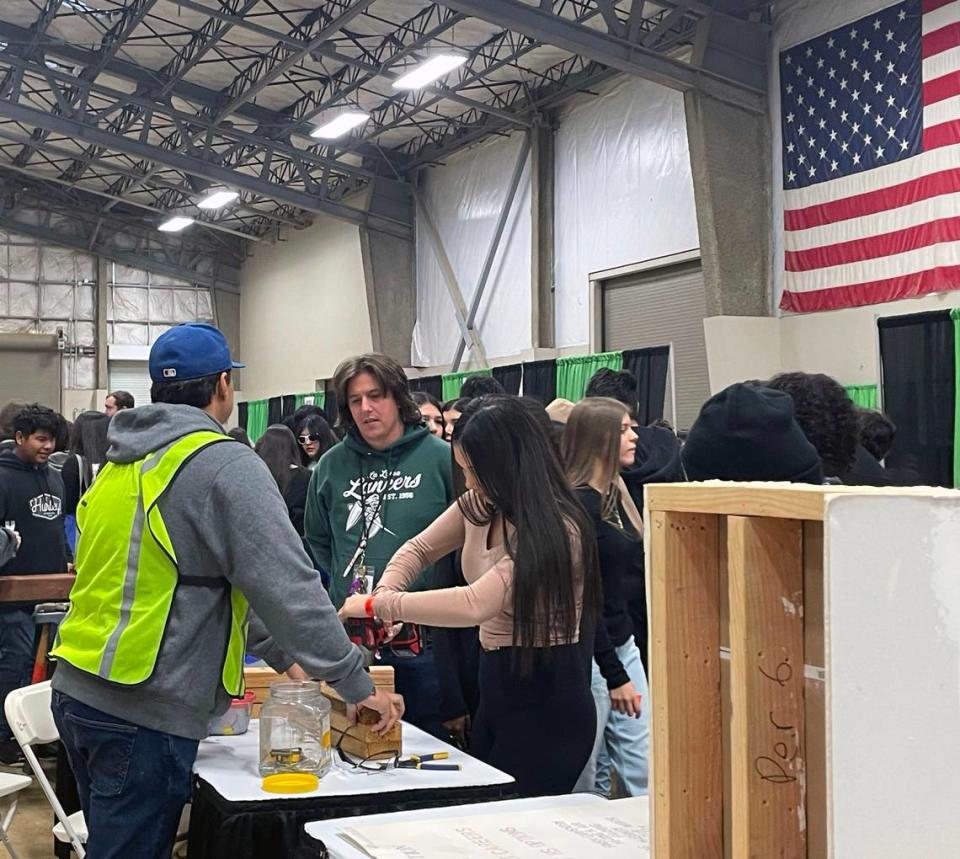Older students show Modesto middle schoolers career options that don’t need college degree
Mack Rodriguez found herself enrolled in her school’s computer science program, a choice she had placed at the bottom of her list of class preferences. Despite her initial reluctance, she developed a passion for the subject and aspires to pursue a career in cybersecurity with the National Security Agency.
“I didn’t switch out, and I ended up loving it,” Rodriguez, a senior at Enochs High School, said. “It’s so much fun.”
There are 30 million well-paying jobs in the U.S. that do not require a bachelor’s degree, with a median income of $55,000, according to the Georgetown University Center on Education. Career technical education (CTE) pathways expose students to these career paths, dispelling the notion that college is the sole option after high school.
Last week, Modesto City Schools hosted its second annual “Inspire Youth Inspire Dreams” event at Modesto Junior College, showcasing various high school programs to eighth-graders. The students came from middle schools both within MCS and in feeder districts, including Sylvan Union.
For those planning to attend college, CTE classes offer college equivalency, translating into credits. Rodriguez, who still intends to go to college, plans to take the CompTIA Security Plus test at the year’s end. Success in this test opens doors to government job opportunities. It usually costs $400, but for Rodriguez, that’s covered by Enoch’s computer science program.
The CTE program also lets students participate in internships, which help bolster their college applications and resumes.
During the MJC showcase, Rodriguez engaged with middle school students, passing flyers to those interested in exploring computer science classes in high school. Ten minutes before the event, she programmed a Matrix-esque code, running it on her laptop screen to catch the attention of the attendees. She observed curiosity from the kids, particularly those interested in video game development.
“I had no idea what I wanted to do, and this just guided me. It gave me all the things I needed if I wanted it,” Rodriguez said about the CTE program.
INCREASED GRADUATION RATES
According to the U.S. Department of Education, students who engaged in CTE during high school exhibited higher graduation rates compared to their non-CTE peers by 94% to 86%. They also demonstrate a greater likelihood of either enrolling in college or securing full-time employment within eight years of high school graduation.
The majority of participants in Modesto City Schools’ CTE programs are Latino students, comprising 62%. Following closely are non-Latino white students, at 21%.
Rachelle Barkus, senior director of education options at Modesto City Schools, said student interests still generally align with gender stereotypes. For instance, female students tend to show interest in nursing, while male students lean toward fields like welding.
For that reason, the event intentionally featured both female and male teachers at each booth to encourage diversity across various career pathways.

A SHORTAGE OF TECHNICAL WORKERS
After the “No Child Left Behind Act” was signed in 2001, funding for CTE declined as the emphasis shifted toward college attendance.
In 2014-15, a trend emerged where students were diverting away from certain industries due to a growing preference for higher education, according to Barkus. In response, the state introduced the California Technical Education Incentive Grant to inject additional funding into these programs.
Today, each grant awarded to school districts yields about $1.5 million to $2 million, providing crucial financial support for CTE initiatives.
More students are opting for certificates or technical colleges, attracted by the prospect of higher pay. Barkus also believes this shift might be attributed to a general sense of burnout from the remote learning experience during the pandemic. Students crave more hands-on, kinesthetic learning opportunities, she said.
Ryan Poulsen, who teaches construction woodworking technology at Modesto High School, said most kids are advised to go to college, but acknowledges it’s not for everyone.
Many students, he noted, find themselves burdened with student loan debt and engaged in coursework unrelated to their interests or skill sets. “It’s hard to tell someone that maybe you shouldn’t go to college, but you should get some training,” Poulsen said.
Professions that don’t require a college degree can offer substantial pay. Poulsen said he earns more from construction work over the summer than he does as a teacher, even after 18 years in the education field.
He also sees it as an ideal career for students who prefer active, hands-on work over spending the day in front of a computer.
Poulsen said he knows the utility of CTE for many students but recognizes its limitations. Most students don’t know what they want to do in high school, so there’s a chance they won’t end up pursuing a career based on classes they chose during their freshman year.
A VARIETY OF CAREER OPTIONS
Ahead of the event, the eighth-graders completed a career exploration worksheet to identify potential areas of interest, like public services, engineering, architecture and transportation.
Many students gravitated toward interactive booths. At one featuring culinary arts, they could observe cooking with pasta. At the construction table, they could try their hand at hammering.
Students said they found the event a valuable resource in preparing for high school.
Anessa Soto, an eighth-grader at Savage Middle School, initially expressed interest in the hospitality, tourism and recreation sector. But after engaging with representatives at the Forensic Biotech Academy based at Enochs, she discovered new interests and is now considering a future as a nurse or police officer.
Soto appreciated the friendly, approachable nature of the event participants, noting their helpfulness in addressing questions.
She said that contemplating her post-graduation plans is a constant thought. She, however, felt that this event alleviated some of those worries.
“With studying and stuff like that, what do I do in between?” Soto said. “I think this helped.”

